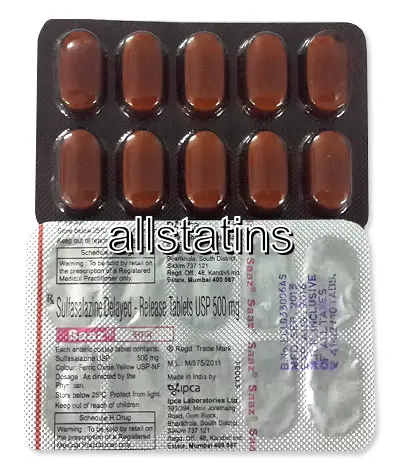Buy Sulfasalazine Online in New Zealand | All Statins New Zealand
| Package | Dosage | Price | Price per Dose | |
|---|---|---|---|---|
| Dosage: 500mg | ||||
| 360 pill | 500mg | NZD1,192.45 | NZD3.31 | |
| 270 pill | 500mg | NZD929.18 | NZD3.44 | |
| 180 pill | 500mg | NZD681.39 | NZD3.78 | |
| 120 pill | 500mg | NZD498.64 | NZD4.15 | |
| 90 pill | 500mg | NZD399.53 | NZD4.43 | |
| 60 pill | 500mg | NZD294.22 | NZD4.92 | |
| 30 pill | 500mg | NZD182.71 | NZD6.04 | |

Sulfasalazine Description
Overview of Sulfasalazine
Sulfasalazine is a medication commonly prescribed to manage certain inflammatory conditions, particularly those affecting the gastrointestinal tract. It belongs to a class of drugs known as aminosalicylates. The medication works by reducing inflammation, thereby helping to control symptoms and improve the quality of life for patients with conditions such as ulcerative colitis and Crohn’s disease.
Mechanism of Action
The therapeutic effects of sulfasalazine stem from its dual components: sulfapyridine and 5-aminosalicylic acid (5-ASA). Once ingested, it reaches the intestines where it is broken down by bacteria. The 5-ASA component provides the anti-inflammatory benefit directly to the gut lining, helping to alleviate symptoms like diarrhea, bleeding, and pain. The sulfapyridine component, meanwhile, has some antibacterial properties but is most associated with potential side effects.
Usage and Dosage
This medication is usually prescribed in particular doses tailored to individual cases. Patients often start with a lower dose, gradually increasing based on therapeutic response and tolerance. It is crucial to follow the healthcare provider’s instructions precisely to minimize side effects and ensure optimal benefits. The medication is taken orally, usually with meals to improve absorption and reduce gastrointestinal upset.
Effectiveness in Treatment
Sulfasalazine has been used effectively for decades in the management of inflammatory bowel diseases. Patients often observe a reduction in flare-ups and symptom severity after consistent use. While it does not cure these conditions, it plays an important role in maintaining remission. Its effectiveness can vary depending on the severity of the disease and individual response, but for many, it provides significant relief and improved quality of life.
Potential Side Effects
Like all medications, sulfasalazine can cause side effects. Common issues include nausea, loss of appetite, and headache. Some individuals may develop allergic reactions such as rash, fever, or swelling. More rarely, it can cause blood cell abnormalities, liver issues, or gastrointestinal problems like diarrhea. Patients are advised to have regular check-ups and blood tests to monitor for adverse effects and to report any unusual symptoms promptly.
Precautions and Interactions
Before starting sulfasalazine, it’s essential to inform the healthcare provider about any allergies, other medications, or existing health conditions. The drug can interact with certain medicines, including other anti-inflammatory agents, immunosuppressants, and blood thinners. It’s also not recommended for use during pregnancy or breastfeeding unless specifically instructed by a doctor. Patients should adhere strictly to medical guidance to avoid complications and ensure safe use.
Final Notes on Usage and Storage
Proper storage of sulfasalazine is important to maintain its effectiveness. The medication should be kept in a cool, dry place, away from direct sunlight. Avoid sharing the medication with others or using it beyond the prescribed duration. If a dose is missed, it should be taken as soon as remembered unless it is close to the time for the next dose. In such cases, skip the missed dose and resume the regular schedule.
See Also
